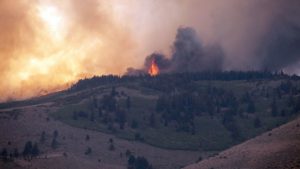The year 2020 will go down in annals of history for many things including one of the worst years for forest fires in Colorado. With much of the state experiencing some stages of drought, in most cases extreme drought, in northern Colorado, the Cameron Peak fire had consumed over 209,000 acres becoming the largest in Colorado’s recorded history. So far in 2020, Colorado has experienced more than 17 fires. From Fort Collins to Boulder and downtown Denver, haze from wildfires burning across the state, as well as the western part of the country, had created very poor air quality. The Colorado Department of Public Health and Environment (CDPHE) said air pollution in the Denver metro area is the worst it has been in the last decade.
There’s been over 30 air quality alerts for the front range and Denver this year. An alert will be issued when particulate matter (PM) is smaller than 2.5 microns. Now, a micron is very small, one twenty-five thousandth of an inch. The reason for the alerts is that if the PM is smaller than 2.5 microns it can get into a person’s respiratory system and their bloodstream. Inhaling this pollution can cause eye irritation, burning in the throat and may cause tightness in the chest, all depending on the activity the person is engaged, for how long and how bad the air quality is outside. Studies have found that wildfires release nitrogen oxide and hydrocarbons that contribute to elevated ozone levels. Elevated ozone levels are a major health concern, particularly in urban areas.
We know that when the air quality is poor it can be hazardous to our health. What happens if smoke from the wildfires comes in contact with a cannabis grow facility? We also know that smoke can stress or even kill the plants—especially those in outdoor or greenhouse operations—and the residue left behind can pose problems. When I see the nightly news, airtankers fighting the wildfires and dropping fire retardant I wondered about the smoke and its effect of cannabis grow facilities in the Denver area.
In California, if cannabis is exposed to a fire retardant, it is recommended that it should not be consumed or sold. What about Colorado?
I contacted the Colorado Department of Public Health and Environment with this concern. My email was forwarded on to the Colorado’s Marijuana Enforcement Division.
This was their response-
‘While our current tests would not look for wildland fire retardants specifically, our regulations do prioritize consumer health and safety. The licensee has a responsibility to ensure product safety. I would recommend reviewing the general sanitary requirements in Rule 3-310. Additionally, if a testing lab were to identify anything that may pose a risk to public health and safety, they would be required to fail the batch and/or notify MED and CDPHE.
More generally, MED continues to work with licensees to determine if there are public safety concerns for the cultivations in affected areas. If the Division becomes aware of consumer safety issues, we will work with licensees to prevent potentially harmful marijuana from reaching consumers.’
Rule 3-310 covers the sanitary requirements of the testing facility, which is not my concern regarding testing practices and procedures. The concern is the chemicals in the air, which are directly coming from wildfire areas and are they hazardous to consumers if they land on any cannabis plant during the grow process?
One of the most effective fire retardants is brominated flame retardants. There is a growing concern about widespread environmental contamination and potential health risks of using brominated flame retardants. Bromine compounds can be added to furniture foam, plastic casings for electronics, upholstery, carpeting, and flame-resistant clothing.
Shawn Honaker, the founder of Yeti Farms in Pueblo, Colorado, has had to deal with wildfires in the past. His business primarily sells concentrates. He said the extraction and the distillation process for a conversion to a concentrate would filter out any harmful additives as a result of smoke or soot containing fire retardant particles. Most marijuana products are tested for heavy metals; Arsenic, Cadmium, Lead and Mercury, but Bromine is not considered a heavy metal. The state of Colorado does not require testing for Bromine.
Should we be concerned about Bromine contamination and was it used on the Colorado fires?
The Jeffco Airtanker Base which operates out of Rocky Mountain Metropolitan Airport, through the end of October recorded 1.7 million gallons of fire retardant that have been dropped to support firefighting efforts in the western United States. Not all 1.7 million gallons of fire retardant was dropped in Colorado. A representative of the Jeffco Airtanker Base told me that the concentrate that was dropped on the Colorado wildfires is called LC95A-R and is made up of fertilizer, salt and a clay product. I contacted the U.S. Forrest Service and a representative from their National Technology and Development Program conveyed to me that the active ingredient in wildland fire retardant is ammonium phosphate, which is a common fertilizer. It works by removing heat from the fire, decreasing its intensity. Bromine is not an ingredient in any of the wildland fire retardants used by government agencies. That was good to hear.
But, should we be concerned if any of the ash or smoke comes in contact with a cannabis flower? The likely hood of the fire-retardant material being in smoke or ash and landing on a cannabis plant in the front range is very remote. If the fire would burn through a fire-retardant line, the fire itself would consume most or all the retardant. The cleansing procedures used by grow facilities would wash off any smoke or ash residuals.
Colorado does require testing for Salmonella, E. Coli, Mold and Yeast. But the bottom line is, we as consumers are not at a risk regarding smoke and ash as it relates to the 2020 Colorado’s cannabis products.

